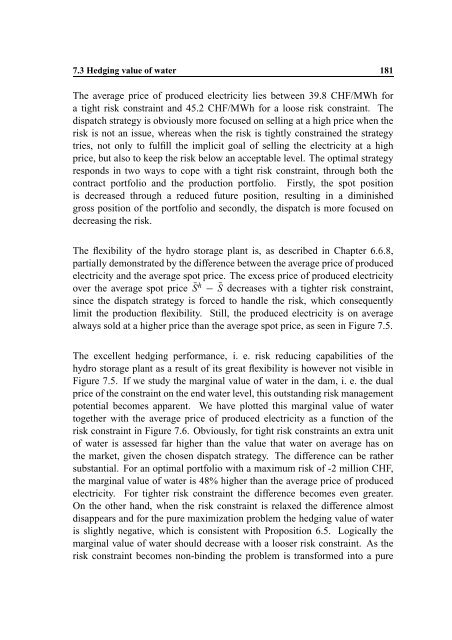Hedging Strategy and Electricity Contract Engineering - IFOR
Hedging Strategy and Electricity Contract Engineering - IFOR
Hedging Strategy and Electricity Contract Engineering - IFOR
Create successful ePaper yourself
Turn your PDF publications into a flip-book with our unique Google optimized e-Paper software.
7.3 <strong>Hedging</strong> value of water 181<br />
The average price of produced electricity lies between 39.8 CHF/MWh for<br />
a tight risk constraint <strong>and</strong> 45.2 CHF/MWh for a loose risk constraint. The<br />
dispatch strategy is obviously more focused on selling at a high price when the<br />
risk is not an issue, whereas when the risk is tightly constrained the strategy<br />
tries, not only to fulfill the implicit goal of selling the electricity at a high<br />
price, but also to keep the risk below an acceptable level. The optimal strategy<br />
responds in two ways to cope with a tight risk constraint, through both the<br />
contract portfolio <strong>and</strong> the production portfolio. Firstly, the spot position<br />
is decreased through a reduced future position, resulting in a diminished<br />
gross position of the portfolio <strong>and</strong> secondly, the dispatch is more focused on<br />
decreasing the risk.<br />
The flexibility of the hydro storage plant is, as described in Chapter 6.6.8,<br />
partially demonstrated by the difference between the average price of produced<br />
electricity <strong>and</strong> the average spot price. The excess price of produced electricity<br />
over the average spot price S h S decreases with a tighter risk constraint,<br />
since the dispatch strategy is forced to h<strong>and</strong>le the risk, which consequently<br />
limit the production flexibility. Still, the produced electricity is on average<br />
always sold at a higher price than the average spot price, as seen in Figure 7.5.<br />
The excellent hedging performance, i. e. risk reducing capabilities of the<br />
hydro storage plant as a result of its great flexibility is however not visible in<br />
Figure 7.5. If we study the marginal value of water in the dam, i. e. the dual<br />
price of the constraint on the end water level, this outst<strong>and</strong>ing risk management<br />
potential becomes apparent. We have plotted this marginal value of water<br />
together with the average price of produced electricity as a function of the<br />
risk constraint in Figure 7.6. Obviously, for tight risk constraints an extra unit<br />
of water is assessed far higher than the value that water on average has on<br />
the market, given the chosen dispatch strategy. The difference can be rather<br />
substantial. For an optimal portfolio with a maximum risk of -2 million CHF,<br />
the marginal value of water is 48% higher than the average price of produced<br />
electricity. For tighter risk constraint the difference becomes even greater.<br />
On the other h<strong>and</strong>, when the risk constraint is relaxed the difference almost<br />
disappears <strong>and</strong> for the pure maximization problem the hedging value of water<br />
is slightly negative, which is consistent with Proposition 6.5. Logically the<br />
marginal value of water should decrease with a looser risk constraint. As the<br />
risk constraint becomes non-binding the problem is transformed into a pure
















